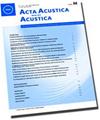Numerical Optimization of a Bicylindrical Resonator Impedance: Differences and Common Features Between a Saxophone Resonator and a Bicylindrical Resonator
Q1 Arts and Humanities
引用次数: 2
Abstract
This paper explores the analogy between a saxophone resonator and a bicylindrical resonator, sometimes called transverse saxophone or cylindrical saxophone. The dimensions of a bicylindrical resonator are optimized numerically to approximate a saxophone impedance. The target is the impedance measured on an usual saxophone. A classical gradient-based non-linear least-square fit function is used. Several cost functions corresponding to distances to the target impedance are assessed, according to their influence on the optimal geometry. Compromises appear between the frequency regions depending on the cost function. It is shown that the chosen cost functions are differentiable and locally convex. The convexity region contains the initial geometrical dimensions obtained by crude approximation of the first resonance frequency of the target. One optimal geometry is submitted to further analysis using descriptors of the impedance. Its deviations from the target saxophone are put into perspective with the discrepancies between the target saxophone and a saxophone from a different manufacture. Descriptors such as harmonicity or impedance peak ratio set the bicylindrical resonator apart from saxophone resonators, despite a good agreement of the resonance frequencies. Therefore, a reed instrument with a bicylindrical resonator could be tuned to produce the same notes as a saxophone, but due to differences in the intrinsic characteristics of the resonator, it should be considered not as a saxophone but as a distinct instrument.双圆柱谐振器阻抗的数值优化:萨克斯管谐振器与双圆柱谐振器之间的差异和共同特征
本文探讨了萨克斯管谐振器和双圆柱形谐振器之间的类比,有时称为横向萨克斯管或圆柱形萨克斯管。双圆柱形谐振器的尺寸通过数值优化来近似萨克斯管的阻抗。目标是在通常的萨克斯管上测量的阻抗。采用经典的基于梯度的非线性最小二乘拟合函数。根据其对最优几何形状的影响,评估了与目标阻抗距离对应的几个代价函数。根据代价函数,频率区域之间会出现折衷。结果表明所选择的代价函数是可微的和局部凸的。凸区包含由目标的第一共振频率粗略近似得到的初始几何尺寸。利用阻抗描述符,提出了一种最优的几何形状进行进一步分析。它的偏离目标萨克斯管是把角度与差异的目标萨克斯管和萨克斯管从不同的制造。谐波或阻抗峰值比等描述符将双圆柱谐振器与萨克斯管谐振器分开,尽管谐振频率很好地一致。因此,带有双圆柱形谐振器的簧片乐器可以调出与萨克斯管相同的音符,但由于谐振器固有特性的差异,它不应被视为萨克斯管,而应被视为一种不同的乐器。
本文章由计算机程序翻译,如有差异,请以英文原文为准。
求助全文
约1分钟内获得全文
求助全文
来源期刊
CiteScore
2.60
自引率
0.00%
发文量
0
审稿时长
6.8 months
期刊介绍:
Cessation. Acta Acustica united with Acustica (Acta Acust united Ac), was published together with the European Acoustics Association (EAA). It was an international, peer-reviewed journal on acoustics. It published original articles on all subjects in the field of acoustics, such as
• General Linear Acoustics, • Nonlinear Acoustics, Macrosonics, • Aeroacoustics, • Atmospheric Sound, • Underwater Sound, • Ultrasonics, • Physical Acoustics, • Structural Acoustics, • Noise Control, • Active Control, • Environmental Noise, • Building Acoustics, • Room Acoustics, • Acoustic Materials and Metamaterials, • Audio Signal Processing and Transducers, • Computational and Numerical Acoustics, • Hearing, Audiology and Psychoacoustics, • Speech,
• Musical Acoustics, • Virtual Acoustics, • Auditory Quality of Systems, • Animal Bioacoustics, • History of Acoustics.

 求助内容:
求助内容: 应助结果提醒方式:
应助结果提醒方式:


